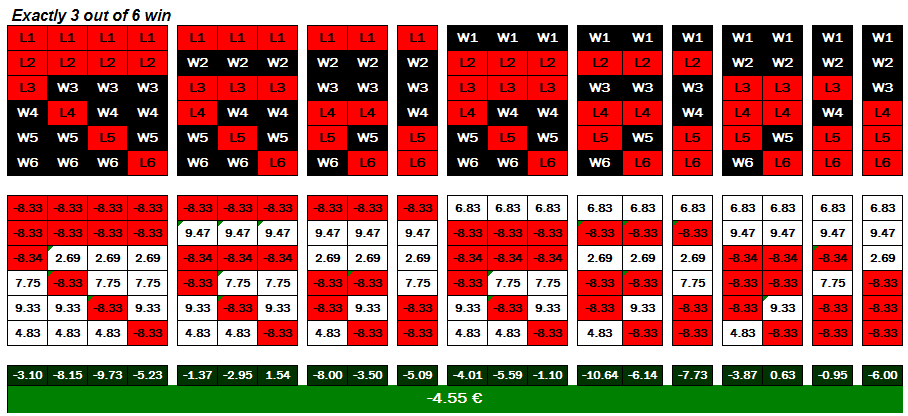Football Permutations Calculator
Posted By admin On 08/04/22Use the Accumulator return calculator to work out your winnings online for all sports. Free, easy to use and mobile friendly bet calculator. The Permutations Calculator finds the number of subsets that can be created including subsets of the same items in different orders. At the same time, Permutations Calculator can be used for a mathematical solution to this problem as provided below. The word 'CRICKET' has $7$ letters where $2$ are vowels (I, E). Vowels must come together. Therefore, group these vowels and consider it as a single letter. The same concept can be applied to additional columns; simply modify the counter to account for additional permutations. For more than two lists, you need to take a different approach with your counter. Try this formula out in Excel. With lists in columns A, B and C, place this formula in column D and drag down to the number of possible. Permutation betting, to reduce the overall risk of betting on multiple selections. The best way to fully explain permutation betting, and the benefits it offers, is to use some examples that show how it works in practice. Example 1 – Two Selections. Our first example is.
While a big part of what I do with football data is predictive, I wanted something that neutrally describes what’s actually possible (and impossible).
I’ve written some code that runs through every possible combination of results from a given round of matches and works out what the league table would look like for each one. It then aggregates these to show what the highest and lowest positions attainable by each club are and how many ways there are of achieving each, to set some expectations around how much the table can change in a given week.
Because I’m interested in what’s genuinely possible (and impossible), I’ve ignored goal difference and just considered three possibilities for each match: home win, draw and away win. This is probably just as well, given that even having just those three possible outcomes for each of the 12 matches in one division represents 3^12 = 531,441 different combinations for my modestly-specced laptop to crunch through.
If I wanted to look at individual scorelines then the numbers quickly become obscene. Even if I only wanted to sim every possible result between 3-0 and 0-3, I’d be looking at a completely unmanageable 16^12 = 281,474,976,710,656 different combinations to simulate per division each weekend.
Here’s what a typical week’s graphic looks like:
The green blob is the highest position a club can possibly rise to and the red is the lowest they can sink for the round of matches in question. Grey blobs – both the small ones and the larger numbered ones – indicate a club’s current position.
The range of possible positions will start out wide at the beginning of a season, narrowing as time goes on and three points starts to represent an increasingly small percentage of the average club’s total. We should also see some patterns as clubs start to cluster into groups and gulfs start appearing in the table.
Result
Distinguished Permutation Calculator
| Permutations, nPr = |
| = | 30 |
| Combinations, nCr = |
| = | 15 |
Permutation Calculator Ncr
Permutations and combinations are part of a branch of mathematics called combinatorics, which involves studying finite, discrete structures. Permutations are specific selections of elements within a set where the order in which the elements are arranged is important, while combinations involve the selection of elements without regard for order. A typical combination lock for example, should technically be called a permutation lock by mathematical standards, since the order of the numbers entered is important; 1-2-9 is not the same as 2-9-1, whereas for a combination, any order of those three numbers would suffice. There are different types of permutations and combinations, but the calculator above only considers the case without replacement, also referred to as without repetition. This means that for the example of the combination lock above, this calculator does not compute the case where the combination lock can have repeated values, for example 3-3-3.
Permutations
The calculator provided computes one of the most typical concepts of permutations where arrangements of a fixed number of elements r, are taken from a given set n. Essentially this can be referred to as r-permutations of n or partial permutations, denoted as nPr, nPr, P(n,r), or P(n,r) among others. In the case of permutations without replacement, all possible ways that elements in a set can be listed in a particular order are considered, but the number of choices reduces each time an element is chosen, rather than a case such as the 'combination' lock, where a value can occur multiple times, such as 3-3-3. For example, in trying to determine the number of ways that a team captain and goal keeper of a soccer team can be picked from a team consisting of 11 members, the team captain and the goal keeper cannot be the same person, and once chosen, must be removed from the set. The letters A through K will represent the 11 different members of the team:
A B C D E F G H I J K 11 members; A is chosen as captain
B C D E F G H I J K 10 members; B is chosen as keeper
As can be seen, the first choice was for A to be captain out of the 11 initial members, but since A cannot be the team captain as well as the goal keeper, A was removed from the set before the second choice of the goal keeper B could be made. The total possibilities if every single member of the team's position were specified would be 11 × 10 × 9 × 8 × 7 × ... × 2 × 1, or 11 factorial, written as 11!. However, since only the team captain and goal keeper being chosen was important in this case, only the first two choices, 11 × 10 = 110 are relevant. As such, the equation for calculating permutations removes the rest of the elements, 9 × 8 × 7 × ... × 2 × 1, or 9!. Thus, the generalized equation for a permutation can be written as:
| nPr = |
|
Or in this case specifically:

| 11P2 = |
| = |
| = 11 × 10 = 110 |
Again, the calculator provided does not calculate permutations with replacement, but for the curious, the equation is provided below:
nPr = nr
Combinations
Combinations are related to permutations in that they are essentially permutations where all the redundancies are removed (as will be described below), since order in a combination is not important. Combinations, like permutations, are denoted in various ways including nCr, nCr, C(n,r), or C(n,r), or most commonly as simply
| ( | n | ) |
| r |
 or B
or BMatrix Permutation Calculator
and then AFootball Permutations Calculator
are chosen to be strikers in those respective orders, only that they are chosen. The possible number of arrangements for all n people, is simply n!, as described in the permutations section. To determine the number of combinations, it is necessary to remove the redundancies from the total number of permutations (110 from the previous example in the permutations section) by dividing the redundancies, which in this case is 2!. Again, this is because order no longer matters, so the permutation equation needs to be reduced by the number of ways the players can be chosen, AFootball Permutations Calculator Online
then B or B thenPermutation Calculator Soup
A, 2, or 2!. This yields the generalized equation for a combination as that for a permutation divided by the number of redundancies, and is typically known as the binomial coefficient:| nCr = |
|
Or in this case specifically:
| 11C2 = |
| = |
| = 55 |
It makes sense that there are fewer choices for a combination than a permutation, since the redundancies are being removed. Again for the curious, the equation for combinations with replacement is provided below:
| nCr = |
|